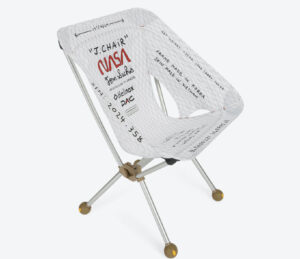Charcoal on Paper as Political Gesture, Sensory Map, and Expansive Voice
Christine Sun Kim has long redefined the boundaries of sound, language, and authorship—not through amplification, but through subtraction. Born deaf and raised in a world where sound was considered an asset she didn’t possess, Kim developed a body of work that critiques, remaps, and ultimately reclaims the territory of sound—visually, physically, and communally. Her newest piece, “Untitled Ripple” (2025), continues this inquiry. Rendered in charcoal on paper, it is deceptively quiet, insistently bold, and conceptually seismic.
At first glance, “Untitled Ripple” appears minimal. A black gesture, wave, or vibration extends across white paper. Yet in this visual mark lies an entire network of resistance, access, temporality, and poetics. Kim doesn’t just draw a line—she draws the echo of a line.
The Medium as a Metaphor: Charcoal and Contact
Charcoal is not a silent material. It squeaks, scrapes, and leaves residue. It demands pressure. It stains. It’s fragile. It requires touch. For Kim, whose work consistently engages with the politics of contact and the complexities of non-auditory sound, charcoal becomes an eloquent tool.
“Untitled Ripple” feels as though it was built on resistance: the resistance of charcoal meeting paper, the artist’s hand negotiating gesture and intention. It evokes sound not through its presence, but through its absence—the space it leaves behind, the suggestion of movement, the space it might once have occupied or is still vibrating in.
In Kim’s hands, this is not drawing. It is recording without playback, speaking without voice, resonating without source.
Visual Language: From Notation to Vibration
Kim has spent much of her career deconstructing the visual grammar of music and language—taking ownership of the lines, staffs, notes, and waveforms used to represent what she has never heard. In works like “The Sound of Oblivion” or “The Grid of Prefixed Harm,” Kim translated abstract sonic concepts into tangible, often humorous visuals. Her TED talk, delivered in sign language and interpreted in voice, was not just a performance—it was a reclamation of frequency, syntax, and gesture.
In “Untitled Ripple,” there are no clefs or tempo markings. Instead, the titular ripple flows across the paper like a waveform. But this isn’t a digital print. It isn’t plotted by software. It’s drawn—an analog echo made physical. The ripple suggests both disturbance and continuation, like the lingering effects of a sonic boom—or a cultural one.
The ambiguity of the title—Untitled—both frees and obscures. It invites interpretation but refuses categorization. And yet, in the word Ripple, Kim offers a precise metaphor: small, often unseen events that radiate outward, altering perception and space.
Deaf Culture, Auditory Capital, and Ownership of Sound
Kim’s work lives at the intersection of identity, authorship, and auditory capital—the concept that sound, like land or labor, is unequally distributed and socially valued. Deafness, under this framework, is often framed as absence. Kim dismantles that. Her art declares that silence is not void—it is structure, agency, and shape.
“Untitled Ripple” doesn’t just visualize a wave; it asserts the Deaf body’s right to define resonance. The ripple is an embodiment of ASL grammar, of facial expression, of the nuanced dynamics of signed conversation. It speaks in vibration and form, not phoneme and decibel. It proposes that sound can be seen, felt, traced—and yes, drawn.
This piece continues Kim’s resistance to “hearing privilege,” the structural biases that value auditory information over other forms. Here, she builds a ripple effect of her own: one that critiques sonic centrality by centering non-auditory intelligence.
Time and Movement: Drawing as Duration
“Untitled Ripple” is not still. It moves. Or rather, it remembers motion. The drawing embodies a duration—a mark that unrolls time rather than freezes it. In this way, it aligns with performance art and sound installation, even though it is a static object. The ripple implies a starting point and a fade—a pulse that may never have been audible but was undeniably real.
It may also echo the temporal dimension of vibration-based communication. For the Deaf community, vibration is both a signal and a metaphor—a knock, a tap, a flash of light signaling presence or intention. This drawing may very well be that signal, amplified through black on white.
The Personal and Political in Untitled Work
Why “Untitled”? Kim frequently uses untitled forms as both poetic negation and defiant ambiguity. In a world where Deaf experience is so often labeled, medicalized, or reduced to inspiration porn, refusing a title becomes an act of resistance to framing. This ripple doesn’t need a context. It doesn’t need to explain itself.
But even untitled, it’s unmistakably hers. The hand is present. The politics are present. The humor is there, too—silent, sly, encoded in the contrast between the expectation of a loud sound and the hushed authority of graphite on paper.
Echoes in the Gallery: Presence Without Performance
To stand before “Untitled Ripple” in a gallery setting is to experience a kind of contrapuntal quiet. It is not demanding. It doesn’t boom. But it lingers. It occupies space not by volume, but by depth. Like Kim’s previous installations at MoMA and the Whitney, this work forces a reconsideration of how presence is built in a room. It is not through noise, but through form, pacing, and clarity of line.
This quietness is radical in an age of oversaturation and visual noise. In this way, “Untitled Ripple” may be the loudest work in the room.
Impression
Christine Sun Kim’s “Untitled Ripple” reminds us that art doesn’t have to raise its voice to be heard. That a line on paper can be a protest, a poem, a performance. That the Deaf body doesn’t live in absence—it vibrates with meaning.
This drawing is not simply a depiction of sound. It is sound translated, resisted, softened, and rebuilt. It is the ripple effect of a voice you may never hear—but cannot ignore.
In the end, “Untitled Ripple” invites us to rethink sound not as sensation, but as permission—to feel, to move, to listen differently.
No comments yet.








